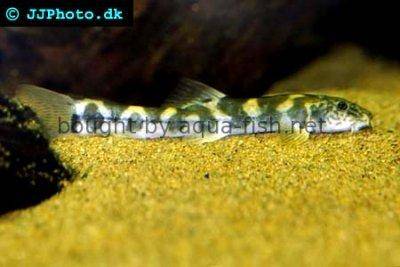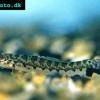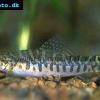Schistura spilota
Scientific name: Schistura spilota
Common name: N/A
Family: Nemacheilidae
Usual size in fish tanks: 8 - 10 cm (3.15 - 3.94 inch)
014
Recommended pH range: 6.5 - 7.1
Recommended water hardness: 4 - 15°N (71.43 - 267.86ppm)
0°C 32°F30°C 86°F
Recommended temperature range: 21 - 24 °C (69.8 - 75.2°F)
The way how these fish reproduce: Spawning
Where the species comes from: Southeast Asia
Temperament to its own species: aggressive/territorial
Temperament toward other fish species: peaceful
Usual place in the tank: Bottom levels
Short description
Schistura spilota is a robust, bottom-dwelling river loach from northern Thailand. Adults reach about 8–10 cm and develop bold, banded patterns along a torpedo-shaped body. This is a territorial Schistura: keep multiple specimens only in a well-structured, high-flow setup with broken sightlines and abundant hides; otherwise sparring is common. Best suited to hill-stream style aquaria with clean, cool, oxygen-rich water. (Not a good choice for delicate or very small tank mates.)
Origin
Endemic to Thailand, recorded from tributaries of the upper Mae Nam Ping (Chao Phraya drainage) in the country’s north; habitat is clear, moderately fast streams over sand, gravel, stones and rock with high oxygenation and little aquatic vegetation.
Food and feeding
An omnivorous benthic forager. In nature it consumes small insects, worms, crustaceans and other micro-invertebrates, plus some detritus. In aquaria offer sinking pellets/wafers and regular portions of frozen/live foods (daphnia, cyclops, bloodworms, chopped worms). Feed after lights-out if shy.
Sexing
External differences are subtle; experienced keepers note slightly broader heads in males when viewed from above, and fuller abdomens in ripe females. (No strong sexual dimorphism is reported in formal diagnoses.)
Breeding
No confirmed home-aquarium spawnings are documented for this species. Like other Schistura, it is presumed to be an egg-scattering spawner, but details for S. spilota remain unpublished.
Lifespan
Typically 5–8 years with cool, clean, well-oxygenated water and a varied diet.
Behavior & compatibility
Territorial with conspecifics, especially as adults; keep as a single specimen or as a group only in larger tanks with many hides and visual barriers. May harass slow or delicate fish at feeding time; combine with similarly robust, fast-water species only.
Tank requirements
- Tank size: 90–120 cm long footprint for a small group; larger for multiple territories.
- Aquascape: sand/fine gravel with rounded stones, cobbles, wood and leaf litter; create caves and broken sightlines.
- Flow & oxygenation: moderate–strong current with high dissolved oxygen (river manifold or powerheads recommended).
- Water quality: cool, very clean, low nitrate; frequent water changes—conditions akin to hill-streams.
Notes on identification
Diagnostic features include 7–10 body bars (anterior bars broader than posterior) and complete/nearly complete lateral line; maximum reported size around 10–12 cm in the literature.
- Flow & oxygen: Aim for high turnover (≈ 10–20× tank volume/hour). Use powerheads or a river-manifold; keep strong surface agitation.
- Filtration: Oversized bio-mechanical filter(s) with pre-filters (sponge) on intakes for safety. Clean pre-filters weekly.
- Aquascape: Fine sand or smooth gravel base with rounded stones/cobbles, stacked to create crevices and broken sightlines. Add wood and a bit of leaf litter.
- Water quality: Cool, pristine, well-oxygenated: 21–24 °C, low nitrate, frequent partial changes (30–50% weekly).
- Lighting & biofilm: Moderate light; allow algae/biofilm on rocks (valuable grazing surface). Avoid “over-scrubbing” décor.
- Feeding strategy: Sinking micro-pellets/wafers, frozen/live small invertebrates; target-feed at dusk if shyer individuals lose out.
- Stocking: One specimen or a group only in long tanks with many hides. Pair with robust fast-water species; avoid delicate, slow fish.
- Safety: Weight/secure rock piles; use tight lids/covers on overflows and intakes.
Pictures
Bought by aqua-fish.net from jjphoto.dk.




 Mottled
Mottled  Banded
Banded